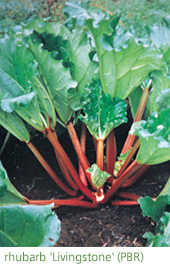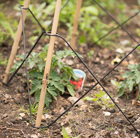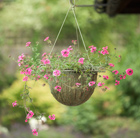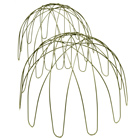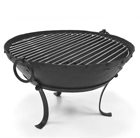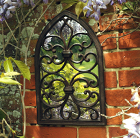|
Luckily many woodlanders also have interesting foliage, which keeps them looking good for the rest of the year. Pulmonarias, for instance, often have handsome foliage that’s spotted and splashed in silver. They get their common name of lungwort from the spotted lung-shaped leaves found in our native form (Pulmonaria longifolia), now found only in Dorset, south Hampshire and on the Isle of Wight.
Pulmonaria belongs to the borage family and this nectar-rich group of plants has the ability to replenish nectar supplies within minutes, so pulmonaria flowers are hardly ever without a bee. Inevitably seedlings follow and many variations have occurred courtesy of the bees. If seedlings are a concern for you, deadheading the flowers as they fade will result in far fewer.

The earliest of all is Pulmonaria rubra, a green-leaved lungwort with tomato-red flowers that can appear as early as January in milder years. It makes a wide, gappy patch, so it’s excellent in a larger garden. Those with smaller areas should consider ‘Raspberry Splash’ instead. This deep pink pulmonaria has neatly formed dark-green leaves that are heavily spotted and dashed - hence the name splash. It’s an American-bred pulmonaria that could survive in a brighter position and its upright habit and tight topknot of raspberry-pink flowers is very attractive.
 ‘Trevi Fountain’, from the same American breeder, is a handsome deep blue and, as the flowers are pollinated, they turn pink. This combination of blue and pinkish red flowers is found in many pulmonarias and it explains another common name - soldiers and sailors. ‘Blue Ensign’, which was discovered as a seedling in Bowles’s Corner at RHS Wisley in the late 1980s, was voted the Hardy Plant Society’s Pulmonaria Group’s favourite blue. The cobalt-blue flowers stay blue, without any hint of pink, and there are no seedlings because it’s sterile. As it pushes through the ground it produces violet spears that stand out against the bare earth. The neat foliage, which flatters the flowers, is mid green with no marks at all. ‘Trevi Fountain’, from the same American breeder, is a handsome deep blue and, as the flowers are pollinated, they turn pink. This combination of blue and pinkish red flowers is found in many pulmonarias and it explains another common name - soldiers and sailors. ‘Blue Ensign’, which was discovered as a seedling in Bowles’s Corner at RHS Wisley in the late 1980s, was voted the Hardy Plant Society’s Pulmonaria Group’s favourite blue. The cobalt-blue flowers stay blue, without any hint of pink, and there are no seedlings because it’s sterile. As it pushes through the ground it produces violet spears that stand out against the bare earth. The neat foliage, which flatters the flowers, is mid green with no marks at all.
 Some pulmonarias have completely silvered foliage and this can look sensational in winter light long before the flowers appear. ‘Silver Bouquet’ is a new pulmonaria that combines silvery foliage with large, outward-facing flowers that veer between coral-pink and violet. It’s unlikely to suffer from mildew, especially if the foliage is sheared off after flowering. Tip a bucket of water over newly cut back pulmonarias and fresh leaves will soon appear. ‘Silver Bouquet’ is very jaunty, but subtler pulmonarias with an almost glacial look include the grey-blue ‘Opal’ and the delicate clean white ‘Sissinghurst White’. Some pulmonarias have completely silvered foliage and this can look sensational in winter light long before the flowers appear. ‘Silver Bouquet’ is a new pulmonaria that combines silvery foliage with large, outward-facing flowers that veer between coral-pink and violet. It’s unlikely to suffer from mildew, especially if the foliage is sheared off after flowering. Tip a bucket of water over newly cut back pulmonarias and fresh leaves will soon appear. ‘Silver Bouquet’ is very jaunty, but subtler pulmonarias with an almost glacial look include the grey-blue ‘Opal’ and the delicate clean white ‘Sissinghurst White’.
Brunnera macrophylla, another member of the borage family, is another good spring addition and the flowers are like dainty forget-me-nots. However it’s the foliage that’s most noticeable and ‘Jack Frost’ has large rounded leaves that are frosted in silver. The green veins and green margins make it look very crisp, whether it’s flowering or not, and the foliage stays neat for many months before needing to be cut back as winter approaches. ‘Betty Bowring’ is white-flowered form with plain green foliage, but its dainty presence makes it worth planting. Omphalodes cappadocica 'Starry Eyes’ is another borage relative, with star-shaped, gentian-blue spring flowers edged in mauve. In summer more nectar-rich, bee-pleasing borage family members include anchusa, echium, heliotrope and of course borage.
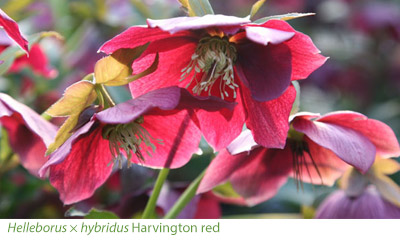
Hybrid hellebores (Helleborus x hybridus) also thrive in town gardens and in recent times plant breeders have given us double-flowered forms, picotees with darkly margined petals, spotted forms and simple saucers in an improved range of colours. When you’re spoilt for choice, it’s worth considering which will stand out best in the garden setting because some of those dark, seductive blacks do merge with the bare soil. If you’re set on something dusky, such as ‘Harvington Black’ or ‘Harvington Shades of the Night’, give it a rich green background. Sarcococca confusa, a scented, compact evergreen, is a perfect backdrop.
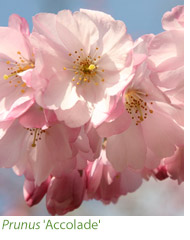 The best stand out hellebores come in white, pale pink, lime-green and yellow and there are spotted and plain forms of doubles and singles. Several of the same colour work well together and the pinks are particularly good under an overhead canopy of pink blossom that might be provided by the flowering cherry Prunus ‘Accolade’. Lime-greens are good against blues, whether it’s a blue pulmonaria or the miniature blue bulbs Scilla siberica or Muscari. Yellows also work with blue, or plant a group that includes at least one double, one spotted yellow, one red-centred yellow and some saucer-shaped yellows. The best stand out hellebores come in white, pale pink, lime-green and yellow and there are spotted and plain forms of doubles and singles. Several of the same colour work well together and the pinks are particularly good under an overhead canopy of pink blossom that might be provided by the flowering cherry Prunus ‘Accolade’. Lime-greens are good against blues, whether it’s a blue pulmonaria or the miniature blue bulbs Scilla siberica or Muscari. Yellows also work with blue, or plant a group that includes at least one double, one spotted yellow, one red-centred yellow and some saucer-shaped yellows.
Although it’s tempting to let hellebores self-seed, the seed pods should be removed because producing lots of seedlings drains the mother plant and generally they are inferior to the parents. They’re greedy feeders and a top dressing of Vitax Q4 after flowering, and again in September, will produce more flower and stronger plants. Cut away any foliage in December to prevent hellebore blackspot from taking hold. The new flowers will appear on their own before the new leaves appear.
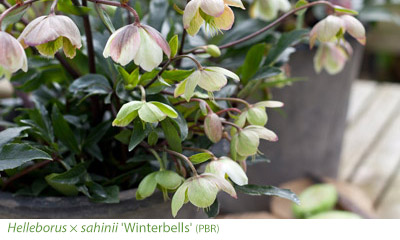
If you have a wilder area there are two hellebore species that can be allowed to self-seed. Helleborus foetidus, often known by its common name of stinking hellebore because it produces a meaty smell designed to attract pollinating flies, has dark divided foliage topped by clusters of maroon-edged green bells. It’s neat and upright and capable of growing in deep shade. There is now a new sterile hybrid between this and the Christmas rose, H. niger, called H. x sahinii ‘Winterbells’, which will flower over many weeks. The multitude of small, pink-backed green bells would look wonderful in a container.
H. argutifolius, also known as the Corsican hellebore, is a sprawler that needs a great deal of space because it lays its stems flat, like the spokes of a wagon wheel. The marbled foliage and apple-green flowers shine early in the year. Cut the stems back after flowering to encourage new foliage, unless you want seedlings.
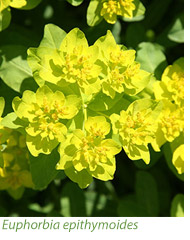 Deep shade always benefits from a blast of spring zing and these two plants deliver acid-yellow flowers. The easier of the two is the truly perennial Euphorbia epithymoides, once called E. polychroma. This deciduous perennial produces a foot high mound covered in acid-yellow bracts and upper leaves, just when the bluebells flower. After flowering new basal shoots (growth at ground level), will appear and the old stems should be cut away to give them the best chance of developing into sturdy stems. This will ensure that your that your plant lives longer and stays compact and vigorous. Deep shade always benefits from a blast of spring zing and these two plants deliver acid-yellow flowers. The easier of the two is the truly perennial Euphorbia epithymoides, once called E. polychroma. This deciduous perennial produces a foot high mound covered in acid-yellow bracts and upper leaves, just when the bluebells flower. After flowering new basal shoots (growth at ground level), will appear and the old stems should be cut away to give them the best chance of developing into sturdy stems. This will ensure that your that your plant lives longer and stays compact and vigorous.
You get the same spring zing effect from the biennial umbellifer Smyrnium perfoliatum. However this will die after flowering so do allow the shiny black seeds to drop onto the ground and germinate. Any seedlings produced will form a rosette of foliage in their first year and then flower in their second. If you want continuity with any biennial plant, let them flower for three consecutive seasons.
Euphorbias, which have tiny star-shaped flowers surrounded by large bracts, make an impact for months. The orange-topped Euphorbia griffithii ‘Fireglow’ is good at filling a dark corner, although do be prepared for it to ramble. It’s usually looking its best when triumph and single-late tulips flower so you could create a contrast with the purple tulip ‘Negrita’ or the almost-black ‘Queen of Night’.

‘Fireglow’ and E. epithymoides are both deciduous, but some early-flowering euphorbias have evergreen foliage that shines during the winter months long before spring flowers appear. The purple form of our native wood spurge, Euphorbia amygdaloides ‘Purpurea’, produces lime-green flowers and beetroot-purple foliage. The compact form Blackbird is an excellent container plant and both will perform in shade. If your town or city garden is sheltered and sunny the Mediterranean E. characias makes a handsome, architectural winter specimen with its handsome silvery stems topped by bent crosiers of chartreuse flowers. Euphorbia characias subsp. wulfenii has dark-eyed flowers that give sharper definition.
 Euphorbia x martini, is a shortish hybrid between our wood spurge (E. amygdaloides) and its Mediterranean cousin E. characias. The soft grey-green whorls of foliage support a stem topped with lime-green flowers, each studded with a tomato-red star. It makes an excellent container plant and the variegated form ‘Ascot Rainbow’, has pink-flushed young foliage. Take care though. All euphorbias are related to the rubber tree and their milky sap can irritate the eyes and skin. Cover up when cutting them back, so that no sensitive skin is exposed, and do wear goggles. Euphorbia x martini, is a shortish hybrid between our wood spurge (E. amygdaloides) and its Mediterranean cousin E. characias. The soft grey-green whorls of foliage support a stem topped with lime-green flowers, each studded with a tomato-red star. It makes an excellent container plant and the variegated form ‘Ascot Rainbow’, has pink-flushed young foliage. Take care though. All euphorbias are related to the rubber tree and their milky sap can irritate the eyes and skin. Cover up when cutting them back, so that no sensitive skin is exposed, and do wear goggles.
As May gets nearer the spears of Solomon’s Seal (Polygonatum x hybridum) finally appear, gaining height extremely quickly. This needs humus-rich soil to do well, along with a sheltered spot. Those green-tipped ivory bells, hanging down in pairs, are very welcome because they signal that spring is beginning to think about turning into summer. Mark its position well though, because the stems emerge so late it’s easy to walk over them.
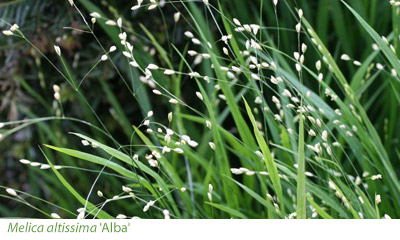
Grasses offer fine contrast and one of the prettiest is wood millet, Melica altissima ‘Alba’. The bright green foliage, which persists through winter, supports white airy heads that resemble collections of rice grains on wires, so this is a lovely trembling grass for a shady spot. It does self seed and fill in the gaps. Bowles’s golden grass Milium effusum ‘Aureum’, one of the few plants that provides golden foliage in winter, is also a generous seeder. They both look fragile and ethereal although they’re both thoroughly rugged in temperament.
|
Things to do
|

















